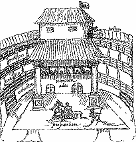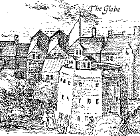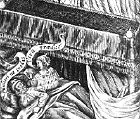How do we know about Shakespeare's stage?
A contemporary sketch
| Johannes De Witt sketched the Swan in about 1596. It is the single most informative document of the period, for it shows the stage itself from the front, in some detail. |
Views of London
| Several artists drew comprehensive views of London, including the major theaters. The views give some idea of the external appearance of the theaters, especially of the Globe. |
Title pages of plays
| Occasionally, particularly in the later seventeenth century, the titlepage of a published play included a woodcut or engraving of the stage. Two important examples are the titlepages of Roxana and The Wits. |
Carpenters' specifications
Stage directions
| The bed, perhaps a curtained four-poster, was probably thrust onto the stage from the door of the tiring-house. Many such stage directions give some idea of Shakespearean practices: "Enter. . . Desdemona in her bed." |
The excavation of the Rose and Globe theaters
| The foundation of the Rose and Globe theaters have recently been discovered, and have partially been excavated. Some of these discoveries are detailed on the screen that deals with the Rose. |
An impresario's diary
| Philip Henslowe kept a Diary during his thirty years as owner of theaters and a company, the Admiral's Men, in London. The Diary has many entries that deal with the purchases of costumes and stage properties. |






